After visitors orient themselves to the Outer Banks, they almost invariably comment on how close to nature everything seems to be. Maritime forests line the western shore, the constant rhythm of ocean waves crashing on the beach are reminders of the natural side of the Outer Banks.
The maritime forests are wonderful for a quick getaway and exploration, but for a day-long expedition, here are two suggestions.
Alligator River National Wildlife Refuge
Located on the mainland in Dare County, Alligator River National Wildlife Refuge (ARNWR) is huge—a little larger than 153,000 acres. It is the second-largest wildlife refuge on the East Coast.
There are a number of different ways to explore it—on foot, kayak, or in a car.
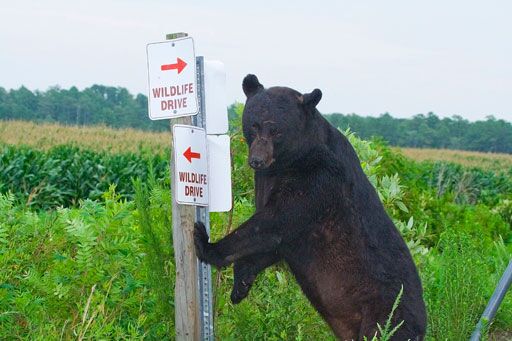
To get to any of the activities at ARNWR, take US 64 west. Signs on the left side of the road will tell of attractions.
ARNWR has one of the largest black bear populations on the East Coast. During the height of the day, they are not very active, but early morning or later in the day, there is a good chance of seeing one, especially in open fields.
Refuge Trails
The hiking trails in Alligator River are pretty tame—no hills to scale, streams to ford. Just a nice level path that is easy to navigate.
The Creef Cut Trail is a short, paved trail that is handicap accessible. It also works well as an introduction to nature of younger children.

About three miles west of the Creef Cut Trail, there’s a sign for Buffalo City and a dirt road on the left. Buffalo City no longer exists, although at one time it was the largest town in Dare County. Its history is colorful and fascinating.
The road is a flat, hard-packed gravel road about two miles long. The trail head for the Sandy Ridge Trail is located at the end, as well as the put-in for kayakers.
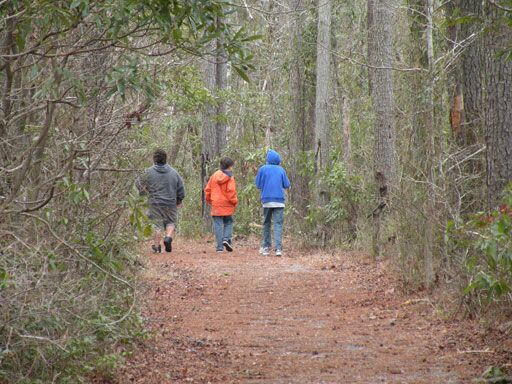
The Sandy Run Trail is proof that at one time the now nonexistent Buffalo City was a thriving lumbering town. The trail is flat and straight and raised above the surrounding marsh and swamp. It was built that way because it was a narrow gage railroad that was used to move logs from the forest to the Militail Creek docks.
You are much more likely to spot wildlife along this trail than Creef Cut. Watch carefully for large ripples in the creek next to the trail, then look for a beaver head. There are turtle everywhere and in the trees, birds sing and tweet to each other.
Kayak Trails
There are a number of kayak trails in the refuge, almost all of them begin their journey at the put-in at the end of Buffalo City Road although there is another access at Militail Creek Road.
The water is calm with few waves or currents—perfect for flatwater kayaking. Paddlers can choose how long they want their journey to be from a nice easy loop around the Sandy Ridge Trail that’s about a mile and a half to paddling between the Buffalo City Road access to Militail Road—5.5 miles each way or 11 miles.
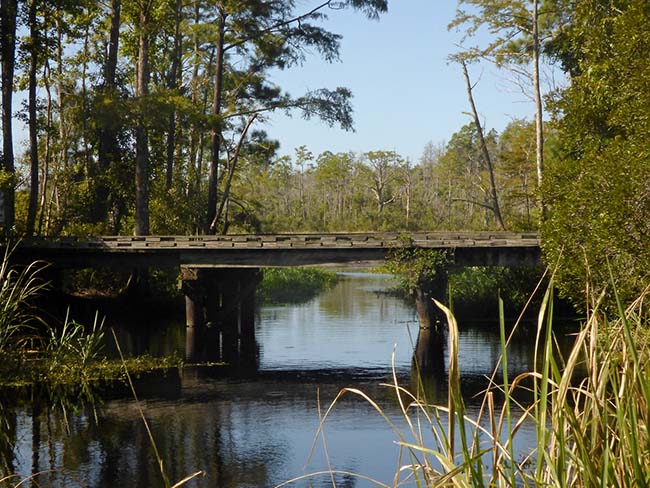
Alligator River is the northernmost reach of the American alligator and the best chance of seeing one is while paddling.
There are a number of outfitters who take tours out throughout the year. Especially for first time paddlers to the area, we recommend taking a tour.
By Car
There is also a wildlife drive that begins on Militail Road. Like Buffalo City Road, the surface is hard-packed gravel. If it has been dry, the road will be dusty.
This may the best chance to see a bear or four. The roads pass through open fields, giving a far better chance to see a bear.
And Now for Something Completely Different
Alligator River is the recovery site for the rare red wolf, a subspecies of wolf that was extinct in the wild. Reintroduced into the wild at ARNWR, the red wolf has made somewhat of a recovery.
To find out how much of a recovery, go to a wolf howling held when there is a full moon. With a trained wildlife biologist howling at the moon, the wolves answer. It’s positively thrilling and eerie at the same time.
Carova
From the end of the paved road north of Corolla to the Virginia state line it’s about 11 miles. Carova is a village at the north end of the area, its name a combination of Carolina (Caro) and Virginia (VA). There are no paved roads for the entire 11 miles and 4WD vehicles are required.
Wild Horses
Carova is best known as the home of the Corolla Wild Horses—a herd of about 120 horses that have been shown to be genetically the closest known link to the Spanish mustangs of the conquistadors. For accuracy’s sake, we’ll mention that the Shackleford Banks herd is also considered a direct link. There are no other wild horses that are considered genetically so close to the original breed.

It is thrilling seeing horses grazing in the grass behind the dunes, or playing on the beach. Especially in the summer, it is actually quite common to see a stallion and his harem (that’s what it’s called) playing in the surf. Experts in horse behavior feel they are in water for the same reason humans are there—on a hot day the water is cool and refreshing.
The best way to see as many horses as can be seen is to go with an outfitter. Although, especially in the summer, there’s a good chance of seeing them on the beach, the outfitters know the hidden places most people don’t know about.
By all means take a camera. And please remember, Currituck County ordinances mandate 50’ from a horse. That is for human as well as horse protection.
The Beach
The Carova beach is different than any other beach on the Outer Banks.
There is, of course, the possibility of an encounter with a herd of wild horses. But there are other things that make the beach unique.
It is a very wide beach—so wide that it functions as the highway north. That does detract just a bit from its appeal but, it is wide enough that avoiding traffic should not be a problem.
The Currituck Banks Coastal Reserve runs parallel to the beach. On the southern end, it is very close and can be accessed from the beach. There are no marked trails in this area, but it can be a fascinating place to explore.
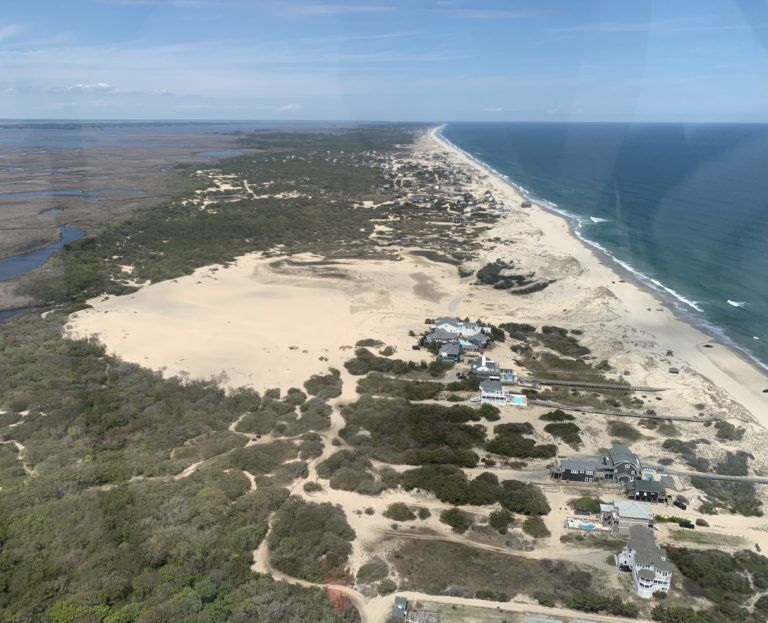
When driving, be aware of the tree stumps. They are not quite as common in the summer, but as fall comes on and ocean action changes, they are almost always exposed. The stumps are the remnants of a once-thriving maritime forest that lived on the western bank of the Currituck Banks. As the barrier island retreated, the trees were inundated with saltwater, died, and have become preserved.
They can do major damage to a car.
Currituck County requires beach parking permits
From the Friday before Memorial Day through Labor Day, Currituck County requires a beach use permit for anyone who will be using the Carova beach.
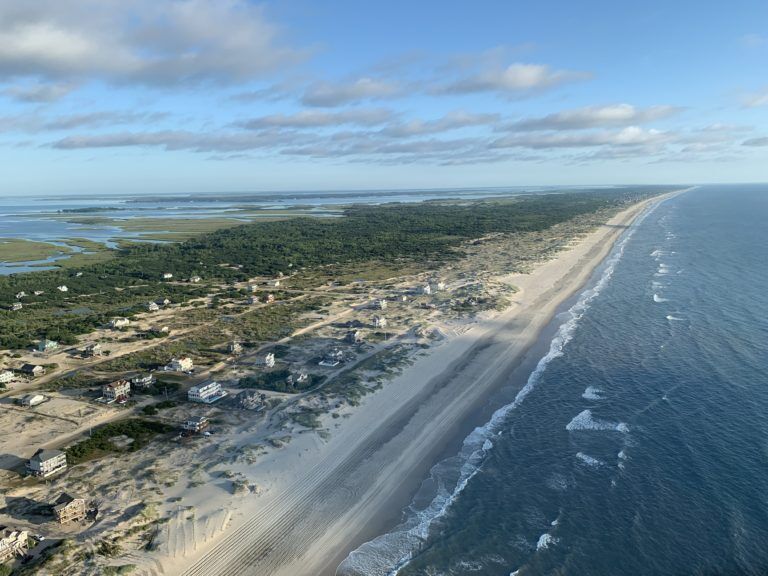
This does not apply to people who are driving through and just wanting to explore the area.
However, if your plans call for surf fishing or spending time with the family on the beach, a permit is required.
The permit is issued to the vehicle. County residents and property owners are issued permits by the county.
There are two types of permits:
Seasonal – Seasonal permits are available to purchase for $150. Property owners will often provide seasonal permit passes to guests.
10-Day – This permit is $50 and is for anyone who wants to park on the beach in the 4WD area.
